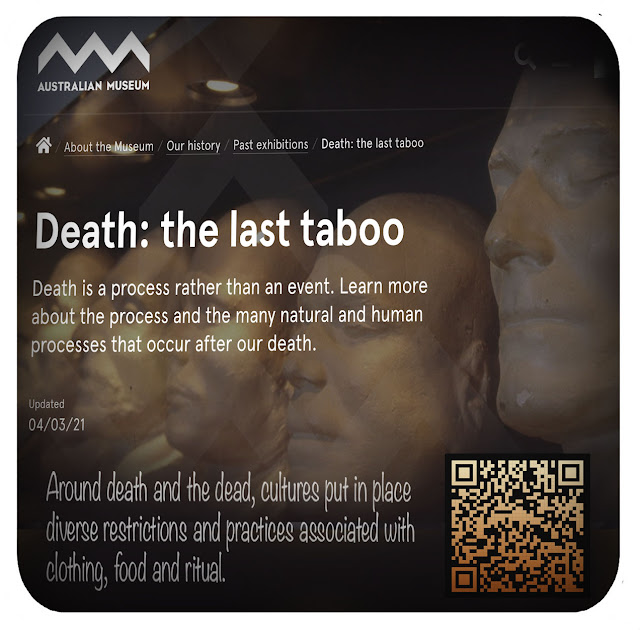There are three main ways that death can be defined: legally, culturally or clinically. Find out what criteria are used to determine the moment of death.
Signs of death
Discover different societies signs of death
Legal definition
In Australian law, death is generally defined as either irreversible cessation of circulation of blood in the body of the person or irreversible cessation of all function of the brain of the person. National Health and Medical Research Council.
Brain death (irreversible cessation of all function of the brain) means death of both the upper brain and brain stem. A person who is brain dead has lost both the capacity to think and perceive, as well as the control of basic body functions. Court challenges to consider upper brain death alone have so far failed, but history suggests that our current definition of death is far from permanent.
In the future it may be possible for individuals to define death for themselves by specifying under what circumstances they want to be considered dead. There is already provision for this in some countries.
Cultural and religious definitions
For the Roman Catholic Church death is the 'complete and final separation of the soul from the body'. However the Vatican has conceded that diagnosing death is a subject for medicine, not the Church. In 1957 Pope Pius XII raised the concerns over whether doctors might be 'continuing the resuscitation process, despite the fact that the soul may already have left the body.' He even asked one of the central questions confronting modern medicine, namely whether 'death had already occurred after grave trauma to the brain, which has provoked deep unconsciousness and central breathing paralysis, the fatal consequences of which have been retarded by artificial respiration.' The answer, he said, 'did not fall within the competence of the Church.'
It remains for the doctor and especially the anaesthesiologist, to give a clear and precise definition of 'death' and the 'moment of death' of a patient who passes away in a state of unconsciousness. Pope Pius XII
Followers of religions like Zen Buddhism, and Shintoism believe that the mind and body are integrated and have trouble accepting the brain death criteria to determine death.
Some Orthodox Jews, Native Americans, Muslims and fundamentalist Christians believe that as long as a heart is beating--even artificially, you are still alive.
.................
Solomon Islands
In the Solomon Islands, society is organised along clan and kinship lines. Pre-Christian religion focused on the ancestors and spirits, and the importance of treating ancestors with appropriate respect, in life as well as death. Deceased Islanders could be interred, cremated, exposed or thrown into the sea, or a combination of these methods.
When a person died, the body was taken a few yards away from the house and was placed in a net in a sitting position ...it was kept for a few weeks before the skull was removed, thoroughly washed in the sea and later taken to the burial site.
Lawrence Foanaota, Director, Solomon Islands National Museum.
In the Solomon Islands, society is organised along clan and kinship lines. Pre-Christian religion focused on the ancestors and spirits, and the importance of treating ancestors with appropriate respect, in life as well as death.
The ancestor spirits inhabit both places and things, and can be invoked for protection or assistance with agriculture, hunting, fishing and relationships. Death was regarded with suspicion and was never seen as accidental, but the result of angry or evil spirits.
Pre-Christian funerary rituals were complex and varied throughout the Islands. Deceased Islanders could be interred, cremated, exposed or thrown into the sea, or a combination of these methods.
Exposure involving leaving the body to decompose, either placed on the rocks, or in a canoe, string bag or tied to a post was very common. In some areas, bodies were weighted with bags of sand or stones, and thrown into the sea.
The skulls of important people, such as chiefs or priests, were collected after initial disposal and stored in wooden effigies, model canoes or in mortuary huts or on stone altars. These then became sites of worship and sacrifice. Relics of commoners could also be stored in wooden figures in a private house.
Tibet
Tibetan Buddhists believe in life as a cycle of birth, death and rebirth. One method of disposal is exposure of the body to carrion-feeders such as vultures, but cremation is also practised and, in the past, some monks were preserved.
After death, the person has left their body and their mind or consciousness has travelled. This body is just a guesthouse in which our mind lives ... The body can't be serviceable without consciousness. So once the mind has left, the body becomes rotten like a dead tree.
Dead trees are only useful for burning.
Thupten Tashi, former Buddhist monk.
Death is not something to fear. You should be prepared for death. After death, the consciousness remains in an intermediate stage, known as bardo, a state between death and rebirth, for up to 49 days.........................



No comments:
Post a Comment